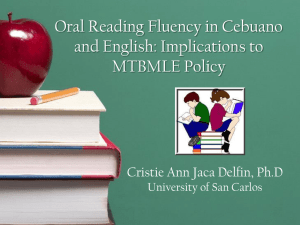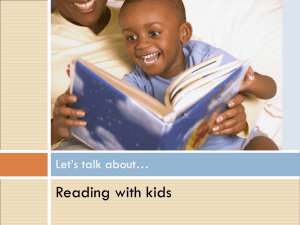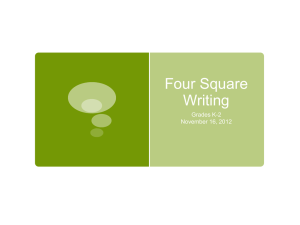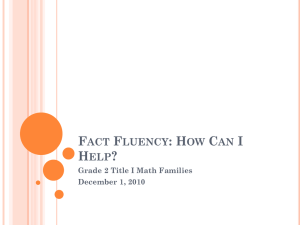Reading Intervention Program Descriptions
advertisement
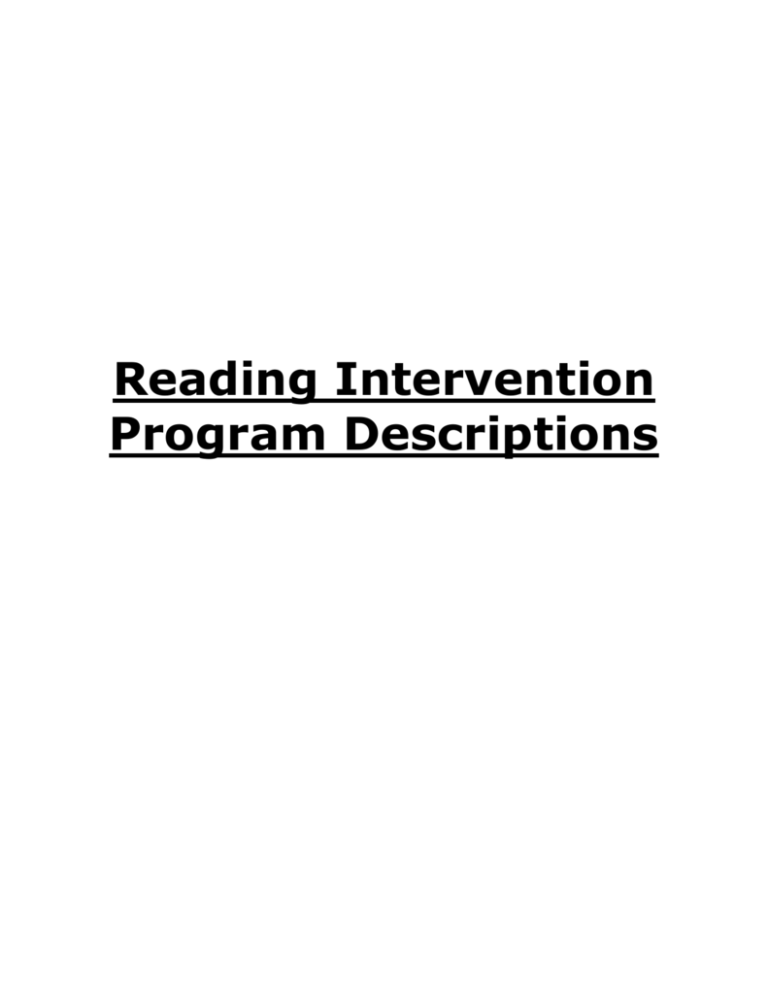
Reading Intervention Program Descriptions Barton Reading and Spelling System The Barton Reading and Spelling System is a one-on-one, Orton-Gillingham tutoring system that was developed to improve the spelling, reading, and writing skills of children, teenagers or adults who struggle due to dyslexia or a learning disability. The Barton System is divided into ten levels. Each level contains from 10 to 15 lessons. (Levels 1 and 2 are a bit shorter.) If a student is being tutored twice a week, it will take from 3 to 5 months to complete a level. All students begin in Level 1. Sequence Number Name of Level 1 Phonemic Awareness 2 3 Consonants & Short Vowels Closed Syllables and Units 4 5 6 7 8 9 10 Syllable Division & Vowel Teams Prefixes and Suffixes Six Reasons for Silent-E Vowel-R Syllables Advanced Vowel Teams Influences of Foreign Languages Greek Words & Latin Roots The level numbers do NOT equate to grade level. They simply indicate the sequence in which the material must be taught. The tutor manual contains everything you need to teach the lessons. Complete lesson plans are provided. Barton uses color-coded letters tiles to make syllable types obvious, and simplify syllable division. Corrective Reading Corrective Reading provides intensive, sustained direct instruction to address deficiencies in decoding and comprehension. The 3 essential goals of the program are increasing reading accuracy (decoding), developing reading fluency, and building reading comprehension. Corrective Reading can be implemented in small groups (4-5 students) or whole-class format. Each lesson is 45-minutes in length and intended to be taught by teachers 4-5 times per week. A complete core program that uses: Two major strands and four instructional levels address a wide range of reading problems. ● Placement tests administered to determine starting point in program. ● The Decoding and Comprehension strands can be used separately as a supplemental reading intervention or combined for use as a comprehensive reading intervention program. ● Fully integrated assessments monitor progress and guide movement through the program. ● Choose the Decoding strand for students who do not read accurately or whose oral reading is choppy, as well as for less fluent readers who lack comprehension when they read. Select the Comprehension strand for students who need to develop vocabulary, background information, and reasoning skills that are the foundation of comprehension. Edmark The Edmark Reading Program uses a whole-word approach to reading instruction. The goal of Edmark Reading Program is to teach 150 sight words including endings –s, -ed, -ing in Level 1, and 200 sight words including compound words in Level 2. Sight words taught within the program represent varying parts of speech. Lessons are delivered daily by a teacher in a one-to-one instructional format. Each lesson lasts 5-15 minutes and more than one lesson per day may be taught, depending upon the student. Paraprofessionals, volunteers, or peer tutors may deliver instruction with management provided by a teacher. Level 1 of the Edmark Reading Program contains five instructional formats: PreReading, Word Recognition, Direction Card, Story Book, and Picture/Phrase Card Lessons, and Level 2 uses three of these formats. A pretest is given before the first Word Recognition lesson, and post tests are given after every 10 words taught. Word recognition and identification are the only reading skills assessed by these pre and post tests. The Edmark Mastery Test (EMT) can be used for continuous progress monitoring, to determine the student’s mastery of the program, and to identify targeted reading objectives for the student’s Individualized Education Program. Materials for the Edmark Reading Program are well-organized, teacher-friendly and all materials needed for teaching, as well as pre- and post-tests are included with each level. The Teacher’s Guide includes an overview of the instructional formats, explicit information about teaching procedures and correction procedures, specific wordings to use during instruction, as well as learning objectives, classroom activity ideas, and research references. Student Record Books assist teachers in tracking a student’s performance throughout the program as well as providing the sequence of instruction. Edmark is commonly used with students with dyslexia. Great Leaps Great Leaps Reading is designed as a supplementary reading program to be used in conjunction with the curriculum currently being implemented. Its primary emphasis is on fluency, with the assumption that comprehension will improve if the child becomes a more fluent reader. The materials consist of an instructor’s manual and student practice pages. Included in the instructor’s manual are assessment guidelines to determine student placement in Great Leaps. Teachers, paraprofessionals, or volunteers administer the lessons in a one-to-one fashion in 5-7 minute daily practice sessions. During those 5-7 minutes, the student reads three timed readings, one under each of the following three headings: phonics, sight phrases, and stories. Each reading is timed for one-minute and the goal is for the student to read each page with no more than 2 errors. Error correction is immediate and followed by modeling of the correct response. When mastery is attained on a page, the student progresses, or “leaps”, to the next page of slightly more difficult material. Herman Method The Herman Method teaches reading in small groups of up to three students. The curriculum provides instruction in phonemic awareness, phonics, fluency, vocabulary, and reading comprehension, while also teaching spelling and writing. It contains 20 modules of instruction through a fifth grade level. Each module includes a reading, spelling, and handwriting component. The curriculum uses direct instruction and drill and practice exercises provided through different media, including flash cards, computer-based software programs, workbook exercises, and guided reading books. The Herman Method is commonly used with dyslexic students. Intervention Station- Harcourt The Intervention Station from Harcourt is a component to the whole group Harcourt- StoryTown core reading program for grades 3-6. The Intervention Station provides scaffolded instruction for key technical skills such as phonemic awareness, phonics, vocabulary, fluency and comprehension. Reading A-Z Reading A-Z consists of two parts: a guided reading component and a fluency component. Reading A-Z offers printable teacher materials to teach leveled reading, phonemic awareness, reading comprehension, reading fluency, alphabet, and vocabulary. The teaching resources include professionally developed downloadable leveled books, lesson plans, worksheets, and reading assessments. Reading Mastery Reading Mastery is designed to provide systematic instruction. Lessons are designed to be fast-paced and interactive. Students are grouped by similar reading level, based on program placement tests. ● Strategy-based instruction that allows students to learn more efficiently ● ● ● ● ● ● Intensive, explicit, systematic teaching to help students achieve a high rate of success Carefully scaffolded lessons that build confidence and independence Ongoing assessments and specific guidelines for remediation to help you make effective instructional decisions Addresses all five essential components of Reading: phonemic awareness, phonics and word analysis, fluency, vocabulary and comprehension Provide spelling instruction to help students make the connection between decoding and spelling patterns Develop decoding, word recognition and comprehension skills that transfer to other subject areas Read Naturally Read Naturally is a fluency program designed to develop in readers the skills necessary for fluent and effortless reading: speed, accuracy and proper expression. Read Naturally may be used flexibly as a supplement to provide extra practice for young readers and as an intervention for struggling readers. Read Naturally is designed to improve reading fluency using a combination of books ad CDs. According to the developer’s website, this program has three main strategies: repeated reading of text for developing oral reading fluency, teacher modeling of story reading, and systematic monitoring of student progress by the students themselves and by teachers. Students work at a reading level appropriate for their achievement level, progress through the program at their own rate, and work, for the most part, on an independent basis. Students use CDs in conjunction with hard-copy reading materials. Read Naturally is intended to be implemented for a minimum of 3, 30-minute sessions each week. Read Well Programs Read Well is a beginning reading program designed for kindergarten through second grade students and for third grade students in need of remediation. The goal of Read Well is to provide students with the foundational skills critical to reading with understanding. Read Well’s inclusive framework incorporates three programs: Read Well K (Units 1-20), Read Well 1(Units 1-38), Read Well Plus (Units 39-50), Read Well 2 (Units 1-20, +21-25) and Fluency Foundations (Units A-J). The main focus of the programs within the inclusive Read Well framework is small group instruction that is mastery based, flexible, and guided by individual, ongoing assessments. Small groups are adjusted frequently based on student performance. The end-of-unit assessments allow teachers to evaluate the progress and needs of each student and to decide whether immediate, intensive intervention or acceleration is warranted. Read Well K also has a whole group component. Several implementation models and lesson plan pacing options are explicitly outlined in the Getting Started program guide to assist teachers in tailoring instruction according to the varying needs of their students. These fully planned lessons for each unit are specifically detailed for differentiated instruction and range from 2 day to 12 day plans. In a typical Read Well lesson, the teacher teaches each small group daily for 30 minutes, with 15 minutes of decoding practice and 15 minutes of story reading. Read Well units are thematically based and sounds and words used in decoding instruction are linked to the unit’s stories, further enhancing students’ ability to make meaningful connections. Each new unit usually begins with one new letter sound which serves as the stimulus for all activities that follow. The new letter sound is related to a word which is related to the theme students will read about later in the lesson. Next, skills that have been previously introduced and mastered by the students are put into immediate practice through the reading of connected text. Read Well provides a unique story format that includes two types of stories: duet stories and solo stories. The duet stories consist of teacher-read text embedded with fully decodable student text; students read the decodable parts and the teacher reads the other parts. The duet stories provide students with rich content, sophisticated vocabulary, and the chance to actively participate in this higher level reading. The solo stories are fully decodable and are read by the students. Vocabulary and comprehension instruction take place within the context of story reading, using expository and narrative texts. Read Well 2 continues to build the foundational skills that are essential to reading more sophisticated narrative and expository text selections with 25 small group units. The last five units accelerate students beyond a second grade reading level. Instruction focuses on low-frequency letter/sound associations, word parts, and multisyllabic word fluency. Students simultaneously expand vocabulary, content knowledge, and comprehension skills. For students who have good beginning second grade phonics skills but lack fluency, Read Well 2 Fluency Foundations is a 10-unit intervention. Students in Fluency Foundations follow the same instructional design as all Read Well small groups—daily decoding, reading fluency instruction, and comprehension and skill work. REWARDS REWARDS is an acronym for Reading Excellence: Word Attack and Rate Development Strategies. It is an intense, short-term intervention reading program that is specifically designed for students in fourth through twelfth grades who have mastered skills associated with first- and second-grade reading but have difficulty reading long words and/or who read slowly (i.e., 60 to 120 correct words per minute). It does not address students who read below a mid-second-grade reading level. Instead, REWARDS provides those intermediate and secondary students who read between a 2.5 and 5.0 reading level with flexible strategies for decoding multi-syllabic words in order to build reading accuracy and fluency. This is accomplished by teaching a strategy to segment a word into parts, read the word part by part, and then read the word independently. Students learn that they can be flexible in dividing the word into parts as long as they can ultimately make the word into a real word. The program consists of 20 lessons lasting 40 to 50 minutes each and is administered by teachers or paraprofessionals in a whole class setting. The lessons are explicit, yet flexible, with a high level of teacher/student interaction. From this, the teacher is able to monitor and make instructional adjustments on an on-going basis. Each lesson includes a description of the activity and a detailed lesson plan. The materials consist of a Teacher’s Guide and a student workbook for each student. The Teacher’s Guide contains black line masters for a pre & posttest, fluency passages, overheads, fluency graphs, and an incentive program employing a point system used for either motivational purposes or to determine grades for the students. Six Minute Solution Six Minute Solution is a reading fluency program that may be used as a supplement to a school’s core reading program or as an intervention. The goal of the program is to help teachers provide students with concentrated practice on phonetic elements, sight word vocabulary, and expository passage reading in order to build overall reading fluency and boost achievement. Six Minute Solution is based on the research of repeated readings and peer-assisted learning strategies, and partner reading is the primary activity of the program. Once an instructional reading level is determined by assessment and teachers have trained students in the partner reading procedure, it takes only six minutes of instructional time per day. Fluency lessons are easily extended and adapted to incorporate extra work in phonics and comprehension. Six Minute Solution lends itself to flexible use in a variety of settings and can be used with the entire classroom where students work in pairs, during small group teacher-led instruction, with cross-age pairs, and with students working individually. Assessments of letter sound knowledge, phonetic elements, high frequency words, and graded oral reading fluency passages are included in the instructional manuals of Six Minute Solution. The pairs are referred to as student partnerships, each consisting of Partner 1 and Partner 2. Each student partnership has a fluency folder that contains two copies of the fluency sheet of phonetic elements, high frequency words, or reading passages, two copies of the fluency record, and a fluency graph or the partner points sheet. Whether the fluency folder of a student partnership contains fluency practice sheets of phonetic elements, high frequency words, or fluency passages is determined uniquely by assessment. To begin the instructional week, students review their new fluency building sheets or practice passages by whisper reading and underlining unknown words without being timed, while the teacher monitors and assists with identifying unknown words. After this, the six minute instructional format involves the teacher announcing that it is fluency time. Partner 1 reads the fluency sheet or passage and continues reading until the timer rings, while Partner 2 listens, marks errors and then gives feedback after the one minute reading. Partner 1 listens to the feedback, pronounces the misread words, and then records this information on the fluency graph. Finally, the students switch roles and begin the same process. Throughout the week, each student receives 3-5 opportunities to read the fluency sheets with phonetic elements, words, or the practice passages. At the end of the week, students turn in their fluency sheets or practice passages for new sheets to be read and practiced the following week. Only by teacher review and an assessment of oral reading fluency, can the reading level of the practice passage be changed. Six Minute Solution consists of three instructional manuals: Primary Level, Intermediate Level, and Secondary Level. The manuals are clearly written, userfriendly, and contain all the necessary information for implementation of the program including assessments, partnership management information, an explicit instructional model with detailed descriptions that may be used for training the students in partner reading, information on expectations for student behavior during partner reading, all of the fluency building sheets, decodable long and short vowel stories, practice passages, and the fluency record and fluency graph. Additionally, there are sample schedules, tips for students who are not making progress, suggestions on making instructional decisions based on the fluency graph, as well as error correction procedures.




